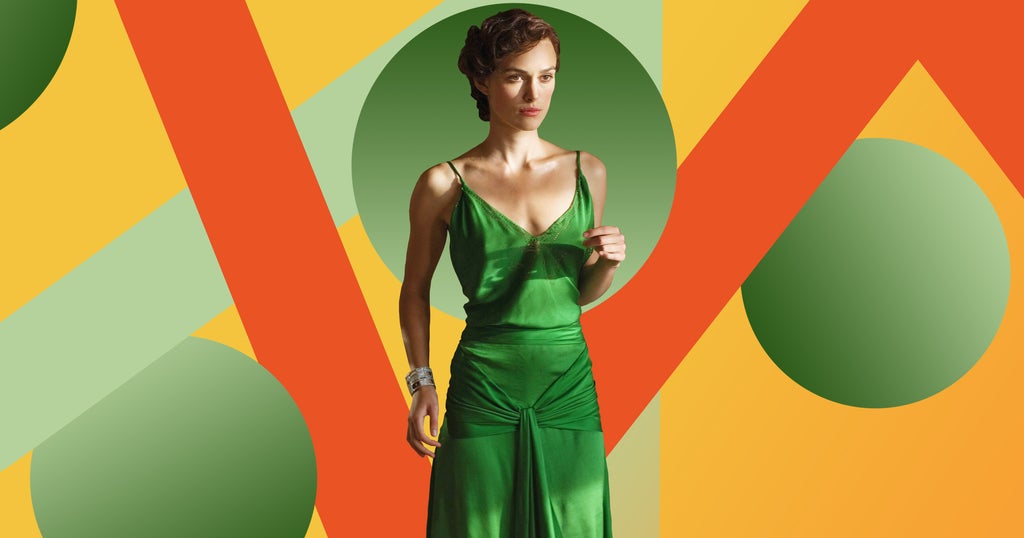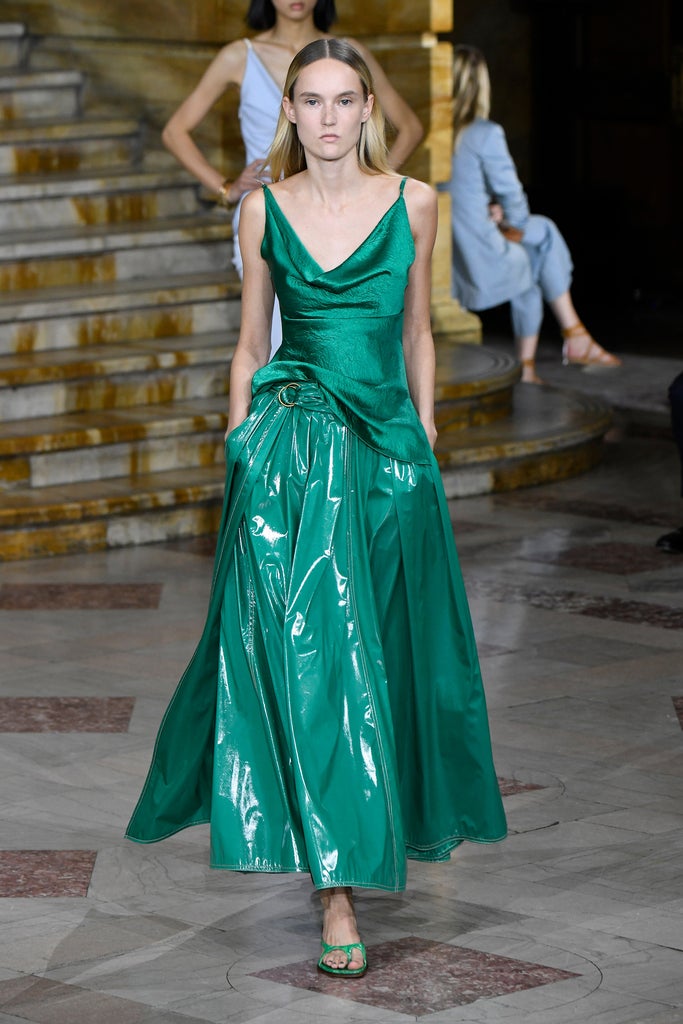
In Joe Wright’s 2007 movie adaptation of Ian McEwan’s book Atonement, there’s much to admire. The shimmering heat of a summer’s day that ends in tragedy. Small moments of intimacy set against the unforgiving backdrop of WWII. A precocious performance from a young Saoirse Ronan, blue eyes narrowed with fierce resolve. But above all, there’s one image that has come to define the whole film: Keira Knightley as Cecilia Tallis in that backless dress, a human slinky of shivering green silk as she lights cigarettes, acts on newly voiced desire, and hugs her arms to her shoulders on the steps in the dark as the evening is plunged into something terrible and uncertain.
It’s a spectacular dress. One that landed costume designer Jacqueline Durran with an Oscar nomination and stole the hearts of thousands of teenage girls, myself included, suddenly desperate to wear something similar (read: rendered in a shinier, cheaper fabric) to their prom. Of course, this is partly down to the shape of the gown itself, capturing all the sultry, bias-cut glamour of the thirties without feeling too much like a period piece. Ultimately, though, it’s in the color, too. Somewhere between fern and emerald and changing tone, like a gemstone, with the light, it’s a seductive green. A green that leaves the viewer aching.


The allure of the green dress has been keenly felt again recently. On the SS20 catwalk they’ve appeared in numerous guises: jewelled and shiny at Sies Marjan; vivid and voluminous at Victoria Beckham; slinky enough to rival Knightley at Galvan; ornately patterned and accented with hot pink at Erdem; bold shouldered at Roksanda Ilincic; half-translucent at Balmain; and extravagantly sleeved at Mary Katrantzou (Jodie Comer recently taking to the red carpet at the Golden Globes in the same dress, imposing in her architectural sweep of green). Often these dresses have been scattered in ones or twos through pink, orange, or blue-hued collections, a refreshing pause – or maybe a pointed exclamation mark – amidst other, softer colors.
That’s the way of the green dress though. It demands attention; often a strange kind of adoration. In softer, mintier shades it can be sweetly ethereal. But a brightly hued green, a green with vibrant, verdant depth, is a powerful thing. Sometimes dangerously so. Back in the 19th Century one of the most popular shades of green dye – Scheele’s Green – was achieved through use of copper arsenite. As the name might suggest, this boldly shaded pigment’s key ingredient was arsenic. It rendered gloves, dresses, and even wallpaper highly poisonous. As art historian Alison Matthews David writes in her excellent book Fashion Victims, it did terrible things to the wearers of such lurid fashions, but the real brunt of this persistent desire for green was suffered by garment workers, with ailments ranging from sores to convulsions to sudden, violent death.

Not all green gowns have had such literal, deadly consequences, though. Sometimes it’s worked a subtler kind of effect – destructive in other, more enthralling ways. Djuna Barnes’ amusing short story ‘The Terrible Peacock’ (1914) details the brief undoing of city reporter Karl, who is despatched by his editor in search of “a woman… more dangerous than Cleopatra, thirty-nine times as alluring as sunlight on a gold eagle, and about as elusive.” This woman with “electrifying” green eyes and bright red hair, who has been allegedly setting hearts and eyes fluttering in Brooklyn, is always outfitted in “slinky” green silk, found at first by Karl clad in a dress “that undulated like troubled, weed-filled water as she moved.”
He immediately falls for this “Aphrodite of the Sea-Foam,” all but forgetting about his date with “Lilac Jane.” It’s a satisfying contrast: insipid-sounding pastel shades set against a sinuous “green goddess whose lure quite possibly spelled destruction.” Although there might be an adjacent, vampier kind of effect were she were clad in another color like red, The Peacock’s green dress suits her exaggeratedly erotic persona perfectly: conjuring images of sirens, folkloric enchantresses, and the thrill of untouchable desire.
Barnes isn’t the only one to have invoked watery images when it comes to the appeal of a green gown either. In Virginia Woolf’s Mrs Dalloway our titular character moves through her much-anticipated party elegantly in a “silver-green mermaid’s dress” with “the perfect ease and air of a creature floating in its element.” In Atonement, too, McEwan writes of Cecilia discarding a pink frock for being too “innocently pale,” instead appraising her emerald-clad appearance: “It was a mermaid who rose to meet her in her own full-length mirror.”
Perhaps we too want to be in thrall to green at the moment – coolly submerged and transformed into something mythic, hungering after its suggestion of unapproachability (think of Gatsby’s green light across the water, or the distant call of Oz’s Emerald City). But as filmmaker and artist Derek Jarman writes in his wonderful book on color, Chroma, “We feel green has more shades than any other color, as the buds break the winter dun in the hedges. Hallucinatory summer days.” For every green dress calling to mind a mermaid, whether benign or deliciously dangerous, there’s another that suggests something entirely different: springtime visions of renewal, gardens spilling over with flowers in June, the neon glitter of disco lights, regal Medieval queens, havoc-wreaking comic book villains, Scarlett O’Hara in Gone with the Wind constructing herself a new gown from “moss-green velvet curtains.” This makes sense. Green, as with all colors, comes with a complex set of symbolic associations, ranging from fertility to envy to growth to poison to money to hope to nature.


Experts have settled on a combination of the latter two to explain the current interest in greens of all shades in the fashion world. In fact, Trend Union has even forecast it to be one of the key colors of the next few years – claiming an optimistic sartorial mood for the summers ahead. However, as much as one might be initially pleased to see anything adding to the growing sustainability conversation, a green garment seems a painfully on-the-nose way to signal participation in caring about the planet. It’s very easy to produce a forest or fern-colored garment. It’s much harder to meaningfully reduce a brand’s hugely harmful environmental impact.
Besides, these explanations don’t quite get at the heart of the subversive brilliance to be found in a green dress. Yes, green can be a reminder of forests and meadows and intricate ecological systems under threat. But it also possesses other, more singular qualities. When I think of the green dress it’s through the lens of Tamara de Lempicka’s paintings and Djuna Barnes’ Terrible Peacock. It’s the detail found in lesbian poet Valentine Ackland’s sad and compelling semi-memoir For Sylvia: An Honest Account, where she describes the youthful fashion in London for committing extravagancies: “I remember wearing a bare-backed, sleeveless bright green evening dress and screwing a horn-rimmed monocle into my eye, and walking down the steps into the Savoy Ballroom like that – at the age of seventeen – for a bet.” It’s selfish actress Maria in Daphne Du Maurier’s The Parasites absconding from family duties to take a boat trip through Paris with her brother, his “camel coat” worn over her green evening dress.
It’s glamour, of a sort. But also something a little more sly: commanding and gorgeous and vaguely unapologetic. A type of dress that really asks us to look at it, and maybe wish that we too were drifting around in bright green, floating, like Mrs. Dalloway, exactly in our element.
Like what you see? How about some more R29 goodness, right here?
Little Women's Fashion Is As Relevant As The Story

No comments:
Post a Comment